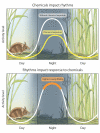Time is of the essence: The importance of considering biological rhythms in an increasingly polluted world
- PMID: 38289905
- PMCID: PMC10826942
- DOI: 10.1371/journal.pbio.3002478
Time is of the essence: The importance of considering biological rhythms in an increasingly polluted world
Abstract
Biological rhythms have a crucial role in shaping the biology and ecology of organisms. Light pollution is known to disrupt these rhythms, and evidence is emerging that chemical pollutants can cause similar disruption. Conversely, biological rhythms can influence the effects and toxicity of chemicals. Thus, by drawing insights from the extensive study of biological rhythms in biomedical and light pollution research, we can greatly improve our understanding of chemical pollution. This Essay advocates for the integration of biological rhythmicity into chemical pollution research to gain a more comprehensive understanding of how chemical pollutants affect wildlife and ecosystems. Despite historical barriers, recent experimental and technological advancements now facilitate the integration of biological rhythms into ecotoxicology, offering unprecedented, high-resolution data across spatiotemporal scales. Recognizing the importance of biological rhythms will be essential for understanding, predicting, and mitigating the complex ecological repercussions of chemical pollution.
Copyright: © 2024 Thoré et al. This is an open access article distributed under the terms of the Creative Commons Attribution License, which permits unrestricted use, distribution, and reproduction in any medium, provided the original author and source are credited.
Conflict of interest statement
The authors have declared that no competing interests exist.
Figures



Similar articles
-
The Minderoo-Monaco Commission on Plastics and Human Health.Ann Glob Health. 2023 Mar 21;89(1):23. doi: 10.5334/aogh.4056. eCollection 2023. Ann Glob Health. 2023. PMID: 36969097 Free PMC article. Review.
-
[Toxicity Testing Organisms for Marine Ecotoxicological Research in China].Huan Jing Ke Xue. 2022 Nov 8;43(11):4888-4904. doi: 10.13227/j.hjkx.202205350. Huan Jing Ke Xue. 2022. PMID: 36437061 Chinese.
-
Unlocking secrets of microbial ecotoxicology: recent achievements and future challenges.FEMS Microbiol Ecol. 2023 Sep 19;99(10):fiad102. doi: 10.1093/femsec/fiad102. FEMS Microbiol Ecol. 2023. PMID: 37669892 Free PMC article. Review.
-
Sensory conflict disrupts circadian rhythms in the sea anemone Nematostella vectensis.Elife. 2023 Apr 6;12:e81084. doi: 10.7554/eLife.81084. Elife. 2023. PMID: 37022138 Free PMC article.
-
Community responses to contaminants: using basic ecological principles to predict ecotoxicological effects.Environ Toxicol Chem. 2009 Sep;28(9):1789-800. doi: 10.1897/09-140.1. Environ Toxicol Chem. 2009. PMID: 19358627 Review.
Cited by
-
EthoCRED: a framework to guide reporting and evaluation of the relevance and reliability of behavioural ecotoxicity studies.Biol Rev Camb Philos Soc. 2025 Apr;100(2):556-585. doi: 10.1111/brv.13154. Epub 2024 Oct 12. Biol Rev Camb Philos Soc. 2025. PMID: 39394884 Free PMC article. Review.
-
Latitude shapes diel patterns in insect biodiversity.Biol Lett. 2025 Apr;21(4):20240622. doi: 10.1098/rsbl.2024.0622. Epub 2025 Apr 30. Biol Lett. 2025. PMID: 40300633 Free PMC article.
-
Timing Matters: Time of Day Impacts the Ergogenic Effects of Caffeine-A Narrative Review.Nutrients. 2024 May 8;16(10):1421. doi: 10.3390/nu16101421. Nutrients. 2024. PMID: 38794659 Free PMC article. Review.
-
Advancing the Spatiotemporal Dimension of Wildlife-Pollution Interactions.Environ Sci Technol Lett. 2025 Mar 18;12(4):358-370. doi: 10.1021/acs.estlett.5c00042. eCollection 2025 Apr 8. Environ Sci Technol Lett. 2025. PMID: 40224496 Free PMC article. Review.
-
Exposure Effects of Environmentally Relevant Concentrations of the Tricyclic Antidepressant Amitriptyline in Early Life Stage Zebrafish.Environ Sci Technol. 2024 Jul 17;58(30):13194-204. doi: 10.1021/acs.est.3c08126. Online ahead of print. Environ Sci Technol. 2024. PMID: 39018108 Free PMC article.
References
-
- Bernhardt ES, Rosi EJ, Gessner MO. Synthetic chemicals as agents of global change. Front Ecol Environ. 2017;15:84–90.
MeSH terms
Substances
LinkOut - more resources
Full Text Sources

